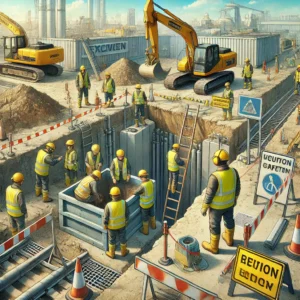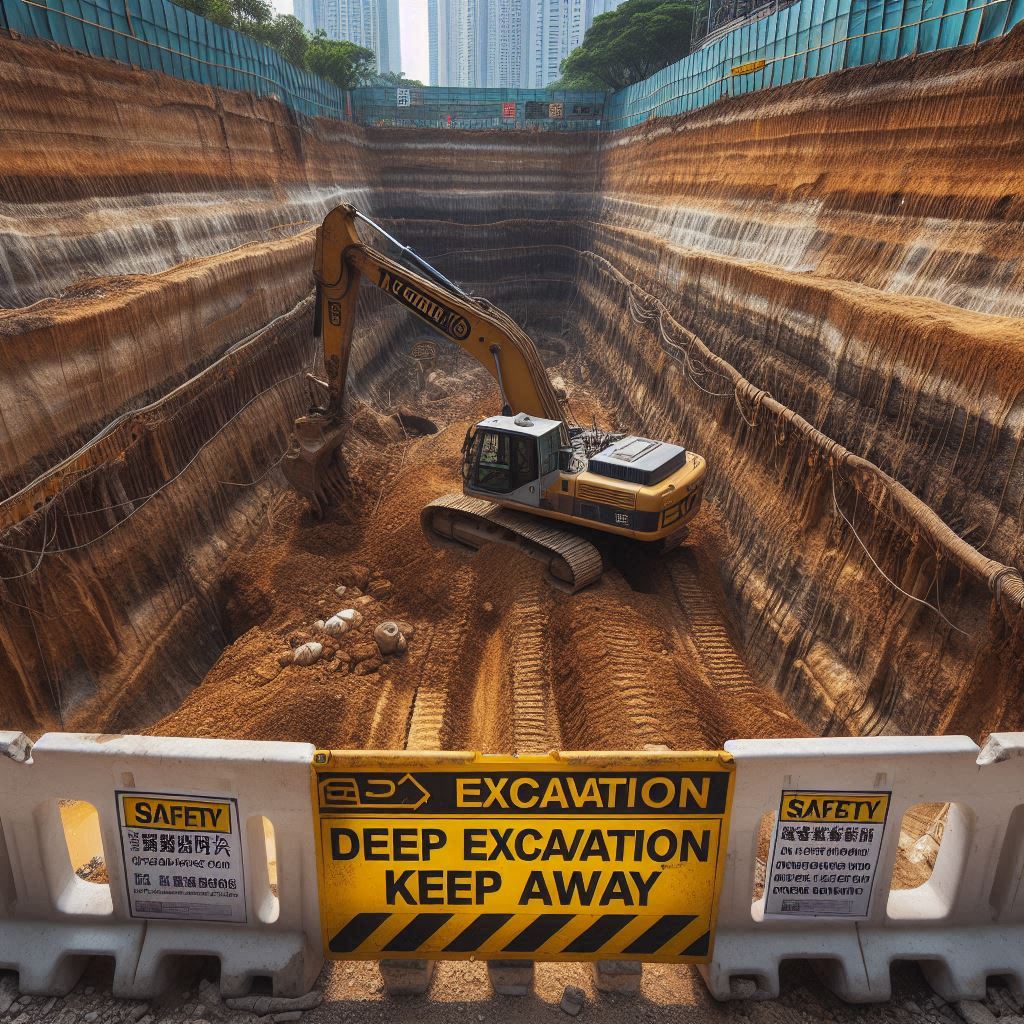Excavation is an essential part of construction, but without proper safety measures, it can pose serious risks. Cave-ins, hazardous atmospheres, and falling objects are just a few dangers that workers face. Implementing effective excavation safety practices is crucial to prevent accidents and ensure compliance with workplace safety regulations.
This guide explores the different types of excavation, the distinction between pits and trenches, soil classifications, confined space concerns, edge protection techniques, shoring methods, and hazard control measures—all with a strong focus on safety.

What is Excavation and Why is Excavation Safety Important?
Excavation involves the removal of earth, rock, or other materials to create an open space in the ground for construction, utilities, or mining. Common applications include:
- Constructing building foundations
- Laying underground pipelines and cables
- Road and bridge construction
- Mining and trenching operations
However, excavation work comes with significant hazards, making excavation safety a top priority. Without proper precautions, workers can face life-threatening risks such as trench collapses, exposure to hazardous gases, and equipment-related injuries.
By implementing these safety protocols, such as protective systems, soil assessments, and hazard monitoring, companies can create a safer work environment.
Types of Excavation
Understanding the different types of excavation helps in selecting appropriate safety measures. Excavations can be classified based on purpose, material removed, or method used.
1. Excavation Based on Purpose
-
Cut and Fill Excavation: This method levels uneven ground. Because it involves moving and managing large amounts of soil, careful soil management is crucial for safety.
-
Trench Excavation: This creates narrow, deep openings for things like pipelines and utilities. Trench shields are essential for protecting workers in these excavations.
-
Basement Excavation: Building a basement requires deep digging. Shoring is vital to prevent collapses and ensure worker safety.
-
Road Excavation: This type of excavation removes soil for road construction. Slope stabilization is often necessary to prevent slides and maintain the safety of the excavation.
2. Excavation Based on Material Removed
- Topsoil Excavation – Focuses on removing the uppermost soil layer while ensuring stability for excavation safety.
- Rock Excavation – Requires blasting or heavy machinery, making protective gear vital for excavation safety.
- Earth Excavation – Involves digging soft soil and clay, requiring sloping techniques for excavation safety.
- Muck Excavation – Removes wet, unstable soil, demanding proper drainage systems to maintain safety.
Each excavation type presents unique risks, making tailored excavation safety strategies essential.
Excavation Pit vs. Trench
Both pits and trenches are common in excavation work, but their characteristics impact safety requirements.
| Feature | Excavation Pit | Trench |
|---|---|---|
| Depth & Width | Wider than deep | Deeper than wide |
| Purpose | Used for basements, tanks, or wells | Used for pipes, cables, and drainage |
| Excavation Safety Measures | Requires proper edge protection | Needs trench boxes or shoring for worker protection |
Since trenches are deeper and narrower, excavation safety precautions such as trench shields and shoring are more critical in trenching projects.
Types of Soil for Excavation Safety
Soil stability plays a crucial role in excavation safety. The four major soil classifications determine the type of protective systems needed.
- Stable Rock – Self-supporting but still requires monitoring for safety.
- Type A Soil – Cohesive (clay, silty clay), making it more stable for safety.
- Type B Soil – Includes gravel and sandy loam, requiring moderate safety precautions.
- Type C Soil – Least stable (loose sand, wet soil), making protective systems essential for safety.
Before excavation, soil testing helps in designing appropriate safety measures such as sloping or shoring.
Excavation Safety in Confined Spaces: Hidden Risks
Some excavation sites may qualify as confined spaces, creating additional excavation risks:
- Limited Entry/Exit – Traps workers inside if a collapse occurs.
- Oxygen Deficiency – Can lead to suffocation.
- Toxic Gas Accumulation – Requires ventilation for excavation.
If an excavation meets confined space criteria, additional safety measures, such as gas testing and rescue planning, are necessary.
Edge Protection Techniques for Excavation Safety
To enhance excavation safety, the following techniques prevent collapses and worker injuries:
- Benching – Creates step-like levels in the excavation wall for improved safety.
- Sloping – Angles the excavation sides to reduce pressure and improve safety.
- Shoring – Uses support systems like hydraulic braces to reinforce walls for safety.
- Shielding (Trench Boxes) – Provides a protective barrier to prevent cave-ins, ensuring excavation safety.
Choosing the right method depends on soil stability and excavation depth.
What is Shoring? Types of Shoring in Excavation
Shoring is a crucial excavation safety method that prevents trench collapses. The main types include:
- Hydraulic Shoring – Uses hydraulic pistons and steel plates for fast safety implementation.
- Timber Shoring – Traditional method using wooden braces for safety in smaller projects.
- Sheet Piling – Uses steel or wooden sheets for deep excavations requiring high safety.
- Beam and Plate Shoring – Uses vertical beams and steel plates for space-constrained safety needs.
Each type improves excavation safety by stabilizing excavation walls and preventing soil collapses.
Excavation Hazards and Control Measures
A strong excavation safety program must address common hazards:
1. Cave-ins
- Use shoring, trench boxes, or sloping for safety.
- Keep heavy equipment away from excavation edges.
2. Falls into Excavation
- Install guardrails and barriers to improve safety.
3. Hazardous Atmospheres
- Conduct gas testing before entry to ensure excavation safety.
4. Water Accumulation & Drowning
- Use pumps and drainage systems for safety in wet conditions.
5. Equipment and Vehicle Hazards
- Maintain a safe distance from excavation edges to enhance safety.
By following these control measures, companies can improve overall excavation safety and prevent workplace accidents.
Conclusion: Prioritizing Excavation Safety
Excavation is a dangerous job, but safety measures can greatly reduce the risks. Employers should make excavation safety a top priority by using protective systems such as shoring, trench shields, and slope stabilization.
Combining engineering controls, thorough worker training, and regular monitoring makes it possible to have both efficient and safe excavation projects. A good excavation safety plan prevents accidents, ensures compliance with regulations, and creates a safer work environment for everyone.
By prioritizing safety in excavation, companies can protect workers, avoid costly accidents, and maintain a strong safety culture.


